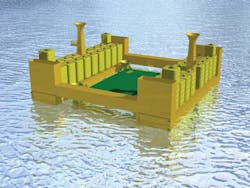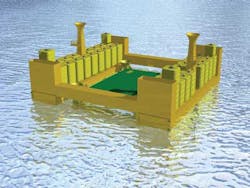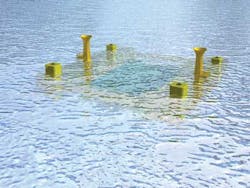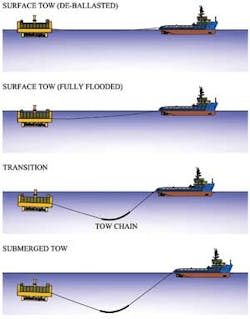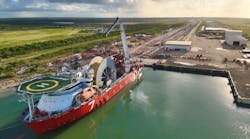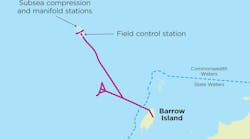David Paul
Arnbjorn Joensen
Subsea Deployment Systems
Increasingly, the subsea industry is being asked to help develop more complex fields in deeper water. These fields can require deployment of large structures in hostile environments which challenge the capabilities of most existing installation vessels. Lack of suitable vessels and restricted operating windows can place significant constraints on the project schedule.
A new subsea deployment system (SDS) offers a cost-effective alternative to a conventionally lifted installation that meets or exceeds the weight and depth capacities of existing vessels. It enables even the smallest crane or anchor handling vessel to transport and install medium to large structures (from 100 t to several 1,000 t) in water depths of 100 m – 3,000 m (328-9,842 ft), and in hostile environments. It offers potential cost savings of 60% on multi-structure installations and up to 80% on single-structure installations.
The system employs a fully submersible vehicle known as the subsea deployment vessel (SDV) to support the subsea structure during transportation, positioning and installation. This vehicle consists of solid buoyancy modules supported on a steel frame. The amount of buoyancy is sufficient to render the combined SDV and payload slightly positively buoyant.
The complete assembly is transported to site using a submerged tow which largely eliminates the effects of the surface environment. It also avoids the often critical phases of offshore over boarding and lowering through the splash zone. Final positioning and set down is achieved by means of chains lowered into the SDV which behave as soft springs and minimize dynamic loading.
Once the structure is landed on the seabed, ballast is added to the SDV to compensate for the weight of the structure prior to disconnection. The ballast is deployed in batches to suit the capacity of the surface vessel, so if the crane's effective capacity is, for instance, 100 t and the structure is 400 t, the ballast would be deployed in four batches.
Another advantage of the system is its relatively low weather sensitivity, which increases the operating window for hostile regions, offering greater schedule flexibility. This is particularly beneficial in emergency response scenarios. The low dynamic loading and the ability to dispense with the need to recover structures to deck offshore also makes the system attractive for salvaging redundant structures.
An affordable and readily available subsea heavy lift capability offers the potential to develop fields with fewer and larger structures, avoiding costly inter-structure connections. It should also facilitate development of more marginal fields. Although heavy lift vessels (HLVs) are frequently used for both the installation of heavy structures and pipelay, removing the need for an HLV offers the potential to adopt a cheaper pipelay vessel, resulting in overall field development savings.
A typical installation will involve load-out, surface tow, submerged tow, positioning, set-down, ballasting and float-off. The structure may be loaded-out into the SDV by a variety of methods, depending on the available equipment and draught, including a direct lift, a submersible barge or a dry dock.
When the water depth is limited at the load-out location, the side hulls are dry and the SDV and structure are towed in shallow draught surface tow mode until reaching a suitable inshore location for flooding the hulls. Once the hulls are flooded, the amount of solid buoyancy is such that the SDV will float with only the castles and chain towers breaking the water surface. The tow wire and chain clump weight are then paid out causing the SDV to submerge fully for the transit to site. The depth of the SDV is adjusted by varying the tow speed and the length of the tow wire.
On approaching the field, the vessel slows down and adjusts the tow wire while keeping the chain clump weight off the seabed until in a designated parking area. The vessel then pays out the tow wire until the clump weight rests on the seabed; at which point the SDV and structure is safely "anchored" and floats above the seabed.
Ideally the length of tow wire between the clump weight and SDV will be marginally greater than the distance between the parking area and the final target location. This allows final set-down without the need to lift and re-position the tow chain clump weight.
The SDV is positioned by means of two control chains suspended from the installation vessel and lowered into the chain towers. The height of the SDV is adjusted by lifting or lowering the control chains and the position, and orientation of the SDV is adjusted by moving the installation vessel and/or the crane.
Once the SDV is in the correct position and orientation, the structure is landed by lowering the control chains until the structure rests on the seabed. The control chains are then fully lowered into the chain towers and temporarily disconnected. The weight of the control chains contributes to the initial on-bottom stability, i.e. prior to ballasting.
Ballast weights are added to the SDV ballast chain lockers by the surface vessel crane to balance the weight of the structure. Once all the ballast is added, the SDV is slightly negatively buoyant and just rests on the structure. The SDV is now disconnected from the structure.
The installation vessel re-connects to the control chains and raises them until the SDV is neutrally buoyant and continues lifting the chains until the SDV floats clear of the structure. The control chains are then removed completely from the towers, allowing the SDV to float above the seabed while remaining safely anchored by the clump weight before being towed back to shore.
Apart from the cost and schedule advantages, the SDS also offers numerous safety advantages compared to a conventional lifted installation. The most critical phases of a conventional lifted installation are typically over boarding, deployment through the splash zone and final set down. Once the over boarding has started, it is generally not practical to suspend the operation before landing the structure on the seabed. Also, a suitable weather window is required which will last for the duration of the entire installation.
The SDS avoids offshore over boarding and deployment through the splash zone. Instead, the SDV and structure are submerged at an inshore location where the environmental conditions are more benign. This significantly reduces the dynamic loading on the structure and installation vessel.
During the final set down with a conventional installation, there is a rapid change of tension in the hoist wire as the structure lands on the seabed. This can result in snatch loads in adverse sea states; and it is therefore desirable to fully release the load as soon as the structure lands. This largely precludes the option to reposition the structure if it has been landed off target. The SDS differs from a conventional installation in that there is no significant change of tension in the control chain down lines when the structure touches the seabed. There is no possibility of snatch loading, and the set down is unaffected by the surface environmental conditions. It is also possible to land the structure and reposition it, if required.
If delays occur during a conventional installation with deteriorating weather conditions, there is a risk of overloading the hoist wires and/or structure due to increased dynamic loading. This could result in failure of the wire and catastrophic loss. The SDS largely eliminates the dynamic loading on control chains, the structure and its connection to the SDV, thereby reducing the risk of a failure. The only hoist wires used in the SDS are associated with the control chains. These are subject to relatively low dynamic loading which reduces the likelihood of failure. Even if failure did occur, it would not result in loss of the structure.
When using the SDS, the structure and SDV are parked close to the seabed and consequently the time for lowering the structure to the seabed is short. This reduces the required weather window, and any delays during the installation are less critical. In addition, the lowering operation can be suspended at any time without risk to the structure or personnel. The control chains are simply withdrawn from the towers and the structure/SDV is safely anchored by the tow chain clump weight.
All individual aspects of the SDS are developed from very basic principles and existing technology, but the combination has resulted in a potential "game changer" for the development, installation and decommissioning of subsea structures.
Operators and contractors worldwide are currently looking at this new system and reviewing its applications with interest, intrigued with the possibilities of widening their options for their forthcoming projects, reducing costs, and – perhaps even more importantly – reducing the project schedule. SDS is looking to align with an innovative partner to bring this concept to market.
Offshore Articles Archives
View Oil and Gas Articles on PennEnergy.com
